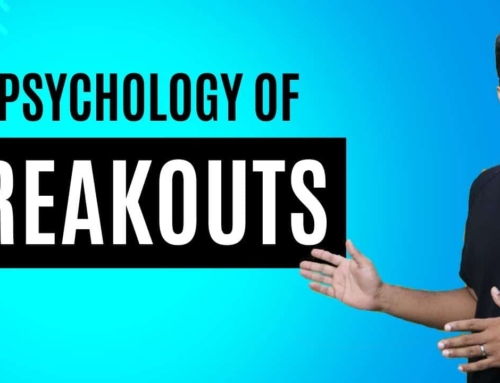What is The Best Technical Indicator?
So guys in this session, I will talk about the best technical indicator that I have used over the years. Before I talk about that specific indicator, let me take a few minutes to explain to you my general view about indicators. If you know me and have been following me, you would know that I am not a very big believer in indicators.
I don’t necessarily take a trade because RSI is about 8o and so I should take a short trade or in MACD, there is some kind of a crossover that is happening and so I should take a long trade. I don’t take a trade just because a technical indicator is showing some kind of a value or is having some kind of a combination with other technical indicators.
As far as I’m concerned, I use technical indicators as my secondary signal system in my broader framework of strategy. If you want to learn what exactly that framework is, what I would recommend is that last year, the National Stock Exchange invited me as a guest speaker to talk about this specific topic. I did that one-hour session with them and it is on our website, the link for which is provided below.
https://www.vrdnation.com/best-technical-indicators
It is called the best way to use technical indicators. You can just go and watch as it is a free webinar. Here, I have talked about how I use technical indicators in the broader context. If you watch, you’ll get a very good sense of how to use technical indicators in your trading journey.
What is the best technical indicator that I have used in my life? For that, I don’t have to think much because the best technical indicator that I have used in my trading journey is the Moving average. Now, it might be sounding a little simplistic and some of you might even argue that RSI is a better indicator or that MACD is a better indicator or a combination of RSI or MACD is a better indicator or for that matter even Ichimoku cloud. There are hundreds of indicators out there and so I will not disagree with you. If you believe that there is something better than moving average, that is your personal experience and I will not disagree with you. If it is working for you, then keep using it. As I said, even though I am saying that the moving average is the best indicator, I will not blindly take a trade because the moving average is telling me something. It is because it’s a secondary aspect for me and that is not the reason for me to take a trade. The reason for me to take a trade is based on a strategy.
All the indicators are doing for me is giving me an entry or an exit signal. Hence I’m not disputing anything out there. I’m just sharing with you what has worked for me and there are 3 reasons why the Moving average has worked out for me.
The first reason is that moving average is the easiest way to see whether a stock or an index is in a trend or not. A plot, a moving average can be 20 days, 50 days or it can be 100 days and you will see most of the stocks that are in an uptrend or a downtrend.
They will honour one of these moving averages. If a stock is in a trend, what will happen is the moving average will be inclined and if the stock is not in a trend, then the moving average will be flat. It is hence a simple, visual way to figure out whether a trend is existing in stock or not. Further, do not underestimate this particular point because as you all know that the trend is our friend.
As a trader, we try to follow the trend rather than going against it. If you are a trend follower, then you should be looking at the moving average to figure out whether there is an uptrend or a downtrend in that particular stock.
The second piece of intelligence that I can find in moving averages, is that a simple moving average gives me a correction of price and correction of time.
Let’s try to understand the concept of correction of price and correction of time using one quick example. This right here is a one-year chart, the daily chart of AU Bank. The red line that you’re seeing here is the 200-day moving average and as you can see, the 200-day moving average is pointing upward.
It means that AU bank is on an uptrend. The way AU bank has performed is that it goes up, comes down, bounces off of the 200-day Moving average and again goes back up. It comes down again, gets the bounce and again gets two bounces from the 200-day moving average. In a way, the 200-day moving average is acting as a support.
Let’s now understand the concept of correction of price and the correction of time. For example, you want to buy AU bank, what will be a good time to buy AU bank? If you were thinking about buying a new bank in August, you could have bought it here, here, here and here. But if you just plotted a simple 200-day moving average and let the prices come to the 200-day moving average, you can see that this would have given you the best price. Whenever you are buying something, which is in an uptrend closer to its moving average, you get the correction of price.
Whatever price they were going higher, they correct and this would be the best deal that you would be getting on this stock. So that was a correction of price
The second is a correction of time. So what happens is, for example, you bought a stock up here, then it went up and then it came down.
So essentially time-wise you have been sitting on this stock for, let’s say 3 to 4 months. It has done nothing for you, but if you wait patiently for it to come to the 200-day moving average and when you buy it from there, you will see that the correction of time has already happened. Now when the bounce back happens, you will see faster results without having to wait for a very long time. Now, again, this is not a rule. It doesn’t work all the time, but it has the advantage that the correction of time has already happened when you’re buying something at the 200-day moving average.
The third reason, which a lot of you probably will not know is in the case of the mutual fund industry, all these mutual fund managers and their teams use Moving averages. Every big asset management company has a technical team that looks at the charts. Though they invest based on the fundamentals of the company, they do not ignore their technical aspect.
One of the aspects that they look at specifically is the 200-day moving average of that stock. I have personally interacted with mutual fund managers and their teams, and have been confirmed on this.
The way they see it is that if a stock is trading about the 200-day moving average, they will consider it to be in a bull market. If it is trading under the 200-day moving average, they will consider it to be in the bearish territory.
So bulls live above the 200-day moving average and bears live below it. If a fund manager wants to buy AU bank, they will wait for AU bank to come back and test its 200-day moving average.
When they buy, the volume with which they will buy will be good enough for retail traders and investors to get the kind of a push that they were looking for. In this case, we align ourselves with the big players and that is the third reason, I believe the moving average is good.
What kind of a moving average do I prefer, is it exponential or simple?
I don’t think that that is as big a deal as it is supposed to be and you can choose any one of them. What then is the timeframe? I would say our 20-day moving average is good for trading, whereas the 200-day moving average is good for investing. However, every stock has a different moving average that it follows when it’s in a trend and while some have shorter moving averages, others have longer moving averages. You will have to play around with the parameters to see what is fitting. The main thing that I wanted to convey here was that this is a very powerful and simple indicator, which has some intelligence built into it.
Even though you may not find it fancy, you will benefit from it if you are trading from a long-term perspective. The moving average will be helpful from a long-term perspective which means you can take positional as well as Swing trades based on that.
Well, the one area where a moving average will not work is in the case of intraday trading. This is where a lot of people use it as a tool in a place where it is not supposed to be used. If you then complain about it, it is not the fault of the moving average, but yours for deploying it at the wrong place.
Let me take an example of a trade that I’m in right now to demonstrate the importance of the moving average and also the importance of the timeframe in which you are applying the moving average. These are the different trades, but let me explain, what kind of rates that I have taken on nifty and bank nifty. This is what we are seeing right now and this is how the market has been behaving.
If you see, this is a 20-periods moving average and you can see that looking at the 20-periods moving average on a 5-minute candle, doesn’t help. It doesn’t tell us a lot.
What exactly should I do? Should I be buying or selling? What should be my positioning in this market based on the moving average on a 5-minute timeframe? However, if I switch the timeframe to a bigger one which in this case, the 20-day moving average, things look much more clearer.
Pay attention to what has happened up until now. The market was in a very strong uptrend and then from the top trend, the market came down and then it touched the 20-day moving average, and not 20 –period moving average. Then from the 20-day moving average, the market is moving back up.
So this is the kind of setup that gives us the confidence that I can take a long trade on the market. This is what I did yesterday. The point that I’m trying to make is that if you look at the moving average from a very shorter period timeframe, you will not understand what to do.
Sometimes you will be right and sometimes you will be wrong, but if you see it on a larger timeframe, you will have much better clarity of what you need to do.
So, guys, that is what I wanted to share with you. The moving average has worked out very well for me, not just from the past few years but, more than a decade now.
I hope that you will also explore this and include that in your analysis.
What is The Best Technical Indicator?
So guys in this session, I will talk about the best technical indicator that I have used over the years. Before I talk about that specific indicator, let me take a few minutes to explain to you my general view about indicators. If you know me and have been following me, you would know that I am not a very big believer in indicators.
I don’t necessarily take a trade because RSI is about 8o and so I should take a short trade or in MACD, there is some kind of a crossover that is happening and so I should take a long trade. I don’t take a trade just because a technical indicator is showing some kind of a value or is having some kind of a combination with other technical indicators.
As far as I’m concerned, I use technical indicators as my secondary signal system in my broader framework of strategy. If you want to learn what exactly that framework is, what I would recommend is that last year, the National Stock Exchange invited me as a guest speaker to talk about this specific topic. I did that one-hour session with them and it is on our website, the link for which is provided below.
https://www.vrdnation.com/best-technical-indicators
It is called the best way to use technical indicators. You can just go and watch as it is a free webinar. Here, I have talked about how I use technical indicators in the broader context. If you watch, you’ll get a very good sense of how to use technical indicators in your trading journey.
What is the best technical indicator that I have used in my life? For that, I don’t have to think much because the best technical indicator that I have used in my trading journey is the Moving average. Now, it might be sounding a little simplistic and some of you might even argue that RSI is a better indicator or that MACD is a better indicator or a combination of RSI or MACD is a better indicator or for that matter even Ichimoku cloud. There are hundreds of indicators out there and so I will not disagree with you. If you believe that there is something better than moving average, that is your personal experience and I will not disagree with you. If it is working for you, then keep using it. As I said, even though I am saying that the moving average is the best indicator, I will not blindly take a trade because the moving average is telling me something. It is because it’s a secondary aspect for me and that is not the reason for me to take a trade. The reason for me to take a trade is based on a strategy.
All the indicators are doing for me is giving me an entry or an exit signal. Hence I’m not disputing anything out there. I’m just sharing with you what has worked for me and there are 3 reasons why the Moving average has worked out for me.
The first reason is that moving average is the easiest way to see whether a stock or an index is in a trend or not. A plot, a moving average can be 20 days, 50 days or it can be 100 days and you will see most of the stocks that are in an uptrend or a downtrend.
They will honour one of these moving averages. If a stock is in a trend, what will happen is the moving average will be inclined and if the stock is not in a trend, then the moving average will be flat. It is hence a simple, visual way to figure out whether a trend is existing in stock or not. Further, do not underestimate this particular point because as you all know that the trend is our friend.
As a trader, we try to follow the trend rather than going against it. If you are a trend follower, then you should be looking at the moving average to figure out whether there is an uptrend or a downtrend in that particular stock.
The second piece of intelligence that I can find in moving averages, is that a simple moving average gives me a correction of price and correction of time.
Let’s try to understand the concept of correction of price and correction of time using one quick example. This right here is a one-year chart, the daily chart of AU Bank. The red line that you’re seeing here is the 200-day moving average and as you can see, the 200-day moving average is pointing upward.
It means that AU bank is on an uptrend. The way AU bank has performed is that it goes up, comes down, bounces off of the 200-day Moving average and again goes back up. It comes down again, gets the bounce and again gets two bounces from the 200-day moving average. In a way, the 200-day moving average is acting as a support.
Let’s now understand the concept of correction of price and the correction of time. For example, you want to buy AU bank, what will be a good time to buy AU bank? If you were thinking about buying a new bank in August, you could have bought it here, here, here and here. But if you just plotted a simple 200-day moving average and let the prices come to the 200-day moving average, you can see that this would have given you the best price. Whenever you are buying something, which is in an uptrend closer to its moving average, you get the correction of price.
Whatever price they were going higher, they correct and this would be the best deal that you would be getting on this stock. So that was a correction of price
The second is a correction of time. So what happens is, for example, you bought a stock up here, then it went up and then it came down.
So essentially time-wise you have been sitting on this stock for, let’s say 3 to 4 months. It has done nothing for you, but if you wait patiently for it to come to the 200-day moving average and when you buy it from there, you will see that the correction of time has already happened. Now when the bounce back happens, you will see faster results without having to wait for a very long time. Now, again, this is not a rule. It doesn’t work all the time, but it has the advantage that the correction of time has already happened when you’re buying something at the 200-day moving average.
The third reason, which a lot of you probably will not know is in the case of the mutual fund industry, all these mutual fund managers and their teams use Moving averages. Every big asset management company has a technical team that looks at the charts. Though they invest based on the fundamentals of the company, they do not ignore their technical aspect.
One of the aspects that they look at specifically is the 200-day moving average of that stock. I have personally interacted with mutual fund managers and their teams, and have been confirmed on this.
The way they see it is that if a stock is trading about the 200-day moving average, they will consider it to be in a bull market. If it is trading under the 200-day moving average, they will consider it to be in the bearish territory.
So bulls live above the 200-day moving average and bears live below it. If a fund manager wants to buy AU bank, they will wait for AU bank to come back and test its 200-day moving average.
When they buy, the volume with which they will buy will be good enough for retail traders and investors to get the kind of a push that they were looking for. In this case, we align ourselves with the big players and that is the third reason, I believe the moving average is good.
What kind of a moving average do I prefer, is it exponential or simple?
I don’t think that that is as big a deal as it is supposed to be and you can choose any one of them. What then is the timeframe? I would say our 20-day moving average is good for trading, whereas the 200-day moving average is good for investing. However, every stock has a different moving average that it follows when it’s in a trend and while some have shorter moving averages, others have longer moving averages. You will have to play around with the parameters to see what is fitting. The main thing that I wanted to convey here was that this is a very powerful and simple indicator, which has some intelligence built into it
Even though you may not find it fancy, you will benefit from it if you are trading from a long-term perspective. The moving average will be helpful from a long-term perspective which means you can take positional as well as Swing trades based on that.
Well, the one area where a moving average will not work is in the case of intraday trading. This is where a lot of people use it as a tool in a place where it is not supposed to be used. If you then complain about it, it is not the fault of the moving average, but yours for deploying it at the wrong place.
Let me take an example of a trade that I’m in right now to demonstrate the importance of the moving average and also the importance of the timeframe in which you are applying the moving average. These are the different trades, but let me explain, what kind of rates that I have taken on nifty and bank nifty. This is what we are seeing right now and this is how the market has been behaving.
If you see, this is a 20-periods moving average and you can see that looking at the 20-periods moving average on a 5-minute candle, doesn’t help. It doesn’t tell us a lot.
What exactly should I do? Should I be buying or selling? What should be my positioning in this market based on the moving average on a 5-minute timeframe? However, if I switch the timeframe to a bigger one which in this case, the 20-day moving average, things look much more clearer.
Pay attention to what has happened up until now. The market was in a very strong uptrend and then from the top trend, the market came down and then it touched the 20-day moving average, and not 20 –period moving average. Then from the 20-day moving average, the market is moving back up.
So this is the kind of setup that gives us the confidence that I can take a long trade on the market. This is what I did yesterday. The point that I’m trying to make is that if you look at the moving average from a very shorter period timeframe, you will not understand what to do.
Sometimes you will be right and sometimes you will be wrong, but if you see it on a larger timeframe, you will have much better clarity of what you need to do.
So, guys, that is what I wanted to share with you. The moving average has worked out very well for me, not just from the past few years but, more than a decade now.
I hope that you will also explore this and include that in your analysis.



![What is Virtual Contract Note [Zerodha]](https://www.vrdnation.com/wp-content/uploads/2023/10/maxresdefault-virtual-note-500x383.jpg)



Leave A Comment